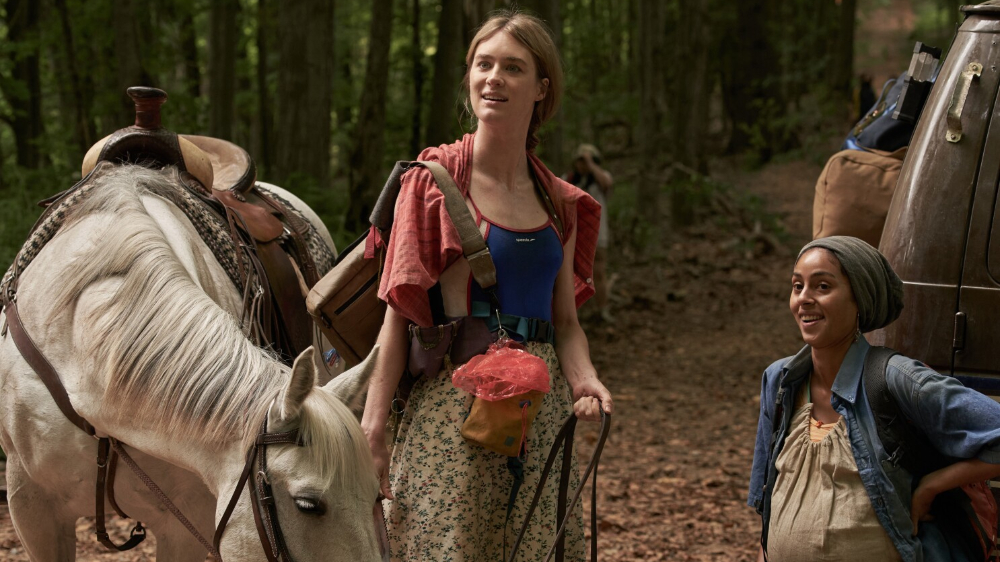
A mysterious flu suddenly wipes out most of the global population in Station Eleven, a 10-episode limited series on HBO Max based on Emily St. John Mandel‘s 2014 bestseller that proved to be all too timely given the ongoing health crisis.
A series about a pandemic that was shot during a pandemic, Station Eleven struck a chord with many viewers in the way it dealt with issues of loss and grieving before, during, and after a virus has completely restructured society. As governments fade away and utilities stop working, survivors are left to fend for themselves and one of the only constants that remain is the power of art
Showrunner Patrick Summerville wrote many of the episodes, while fellow executive producers Hiro Murai and Jeremy Podeswa shared directing duties with Helen Shaver and Lucy Tcherniak. That quartet employed a trio of cinematographers to work on the series — Christian Sprenger who shot the pilot and episode 3; Daniel Grant, who served as DP on Episodes 4, 7, and 8; and Steve Cosens, who photographed episodes 2, 5, 9, and 10.
Over the past 15 years, Cosens has built an extensive career in film and television, and his work on the Chet Baker biopic Born to Be Blue led him to reteam with that film’s star, Ethan Hawke, when Hawke directed the Blaze Foley movie Blaze. Cosens also shot the Elliot Page movie The Tracey Fragments as well as the pilot for the HBO series Tell Me You Love Me.
Below the Line recently spoke to Cosens about Station Eleven via Zoom from Toronto:
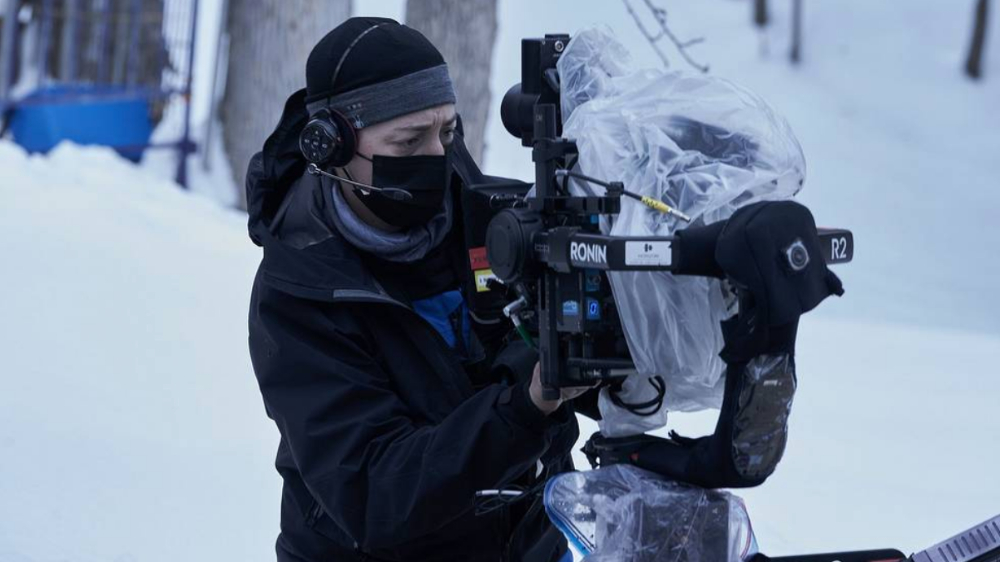
Below the Line: You came onto the show after a long hiatus due to COVID, right?
Steve Cosens: Jeremy Podeswa asked if I would be interested. I’d always wanted to work with him, and I was really excited by what Hiro Murai and Christian Sprenger had done. The style and pacing of their two episodes, how they were approaching the material aesthetically, they were speaking my language. I knew I would be able to jump on board.
BTL: What made those two episodes different from each other?
Cosens: When they started shooting, the series was just sci-fi, something fictional. COVID wasn’t even a thing. To be shooting a series that was about a pandemic was equally strange and weirdly inspiring at the same time, because Patrick Summerville had done such a beautiful interpretation of the original novel.
By their third episode, everything shut down. I don’t think they knew where they were going to start up again, I think they intended to shoot in the U.S., but after COVID they decided to move the show to Canada.
BTL: The series jumps around so much in time, yet the cinematography looks seamless. You are credited with episodes 2, 5, 9, and 10. Did they mix other material into those?
Cosens: By the nature of the show, I think in all the episodes there are snippets of other episodes. But we did have to recreate some of the sets, like the scenes with Miranda (Danielle Deadwyler) in her hotel in Malaysia, and the condo in Chicago where Kristen (Mackenzie Davis) and Jeevan (Himesh Patel) stay.
When I was hired, I was a little bit nervous, wondering how it was going to work. How were we going to synthesize the material and make it look the same, or at least have a common aesthetic foundation to it? Once they hired Daniel, I was like, ‘okay, this will work.’ I knew him already and felt that he approaches lighting in a way that’s similar to what Christian and I do.
For the most part, we all try to use as much natural light and practicals as we can. That’s not an uncommon approach these days, but the three of us were really approaching the entire project in a similar way, so it was easy to kind of fuse our different sensibilities.
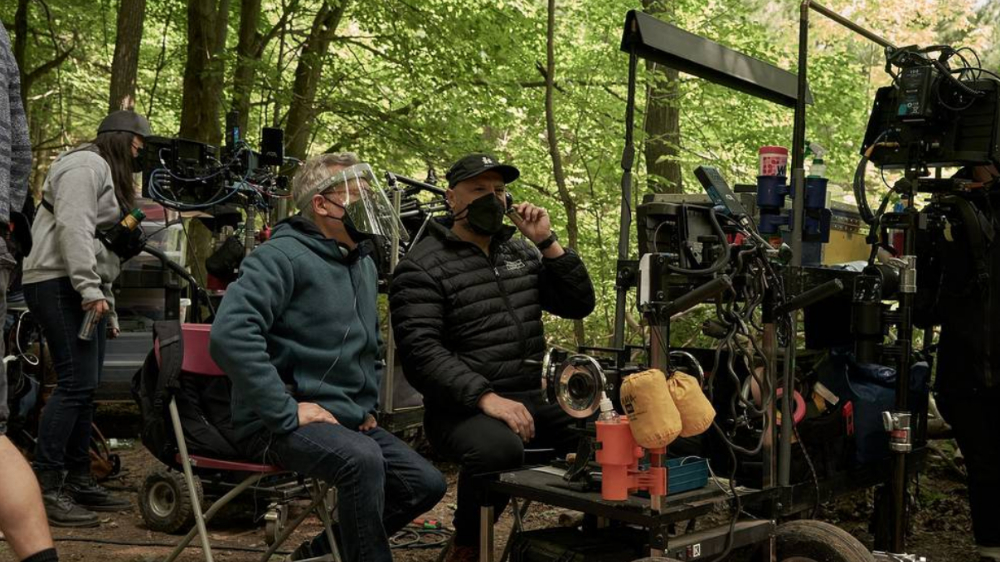
BTL: Well, you’re using basically the same equipment and lighting, but when it comes to things like pushing in on a character or following a character down a corridor, that becomes a personal choice. I was just surprised that the pacing and camera movements were so seamless.
Cosens: I think that for things like pacing, a lot of those choices were steered by Patrick Summerville and David Eisenberg and the other editors. I would say that Patrick’s aesthetics really kind of dominated. He was holding tightly to this sparse aesthetic, where things move at a slightly slower pace, where the world comes at you a bit more slowly.
BTL: Were you using two cameras?
Cosens: Yeah, most of the time we had two cameras going. We shot with the mini Alexa Mini LF. When you shoot TV, you’re kind of forced to use two cameras because production is paying for it. On this show that wasn’t always the case. If it wasn’t a nice shot, we just didn’t shoot it.
BTL: Did you operate?
Cosens: I love operating, but I wasn’t on this. I used an operator. Quite a bit of the show was shot on a Ronin, a gyro-stabilized head. My operator, Sasha Moric, it’s kind of his thing. I would say he’s the best around. I never worked with anybody better than he is and I’ve shot quite a bit with him. We speak a similar language and we can move fairly quickly and fluidly.
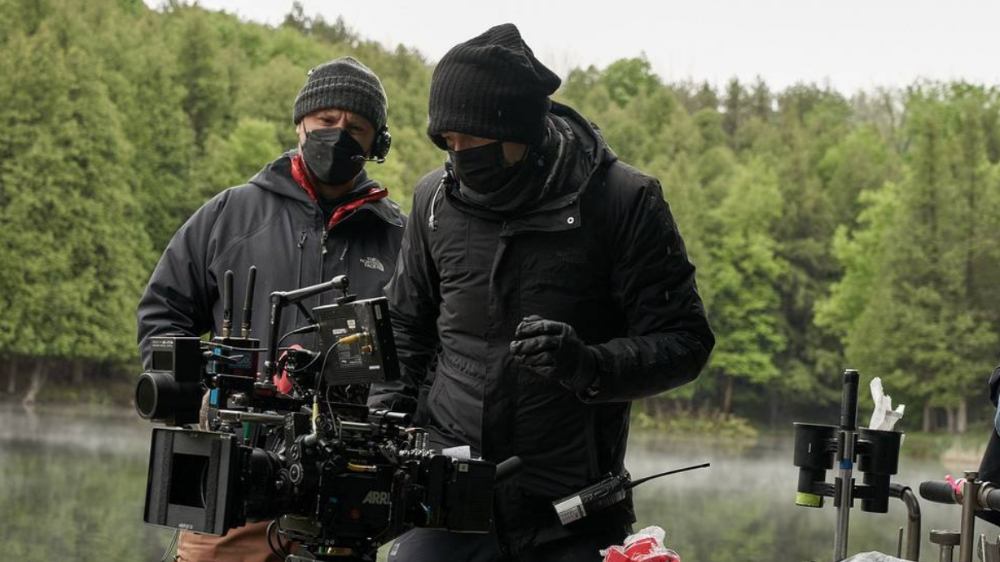
BTL: Many of the winter scenes you shot take place in an abandoned vacation house. What can you tell us about that location?
Cosens: We started in the winter at that cottage. It was such a beautiful location. We really fought hard to get production to let us shoot there because it was logistically really challenging. Not just getting all the equipment and people in there, but also they were getting a ton of snow. The crew were like, ‘Oh my God, is this any indication of what it’s gonna be like for the rest of the show?’ And we were like, ‘No, no, no, no, no, it’s gonna be fine.’
That sequence where Jeevan is wounded and crawling through the snow, it just happened to start snowing that day. We actually ended up getting quite lucky. We had snow when we needed it, and no snow when we didn’t need it.
BTL: You also shot a lot of material at an actual airport, right?
Cosens: When I was reading the script and seeing all the material that was gonna be shot in the airport, I was like, ‘Oh man, how are we gonna do this?’ Because you always end up shooting airport material at convention centers or libraries.
For this, the city of Toronto has a wing of Toronto Pearson Airport that they leased out to a company that rented it for film production. We were the first ones to use it. When we walked in there, it was incredible. We could see for 150 feet in either direction. We could have full control. We literally pulled a plane up to the jet bridge to shoot stuff.
As far as lighting, it faced north and east. For most of the day, beautiful ambient light was coming in. All the windows had blinds that I could raise or lower to control the contrast. It was a really easy location most of the time, although you had to treat it like an exterior because the windows were so present. Towards the end of the day, when you start to run out of light, your day was done. We had to be careful about how we structured day versus night scenes.
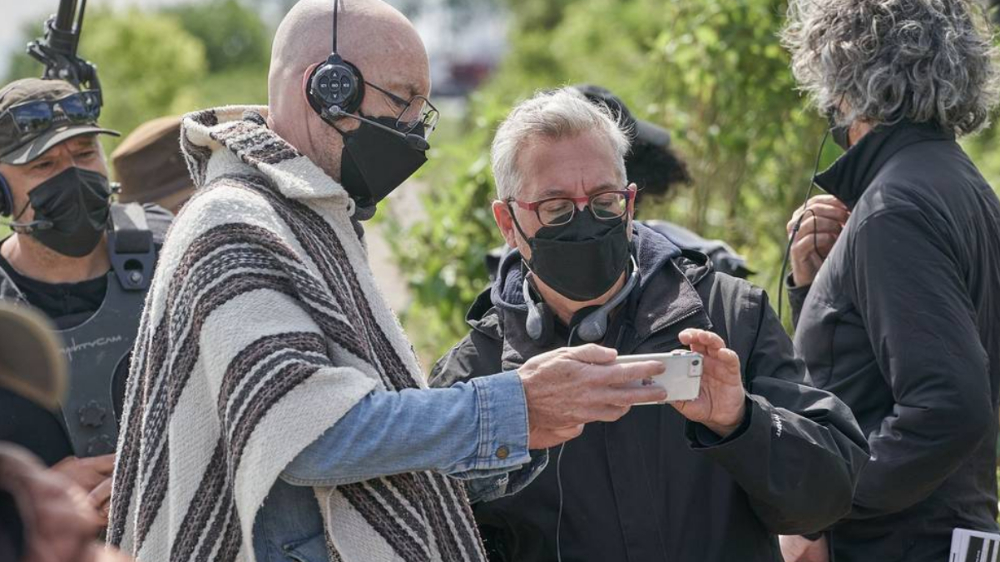
BTL: Can you talk about staging Macbeth at the airport?
Cosens: First and foremost, it was important to me that all the Shakespeare material be shot with natural flames. So Ruth Ammon, the production designer, and I worked really closely together to run gas lines through all the Traveling Symphony’s trucks and wagons. That way I could have control over the stage lighting. I could turn some lights off If I didn’t need them. I could bring up the flames in the background shots, and really sculpt the faces on stage by dialing the gas up and down. Ruth just did such an amazing job. I loved that the wagons and trucks convert out onto a stage, that was brilliant.
Jeremy was really instrumental [in] blocking what happens on stage. When you’re putting on a play, you rehearse for weeks just to figure out the blocking. We really only had one day of rehearsals. I know Jeremy felt in the end that he didn’t have enough time to get it on its feet the way he wanted.
BTL: Did you have a shot list? Were you able to isolate the lines you needed closeups for?
Cosens: There were some moments that we had specific camera angles for. Hero moments, like when the Prophet pulls out a knife and holds it to the throat of an actor.
We also just did a lot of coverage. We had a couple different shots here and there, knowing that in the end they might be shaped slightly differently in the edit.
Everyone knew this was essentially the climax. The actors were all really dialed in. They had had some time to work together by themselves.
It went relatively smoothly. In TV, you’re always up against time. Even though it’s all on stage, it was actually a very complicated sequence to set up and we just didn’t have a lot of time.
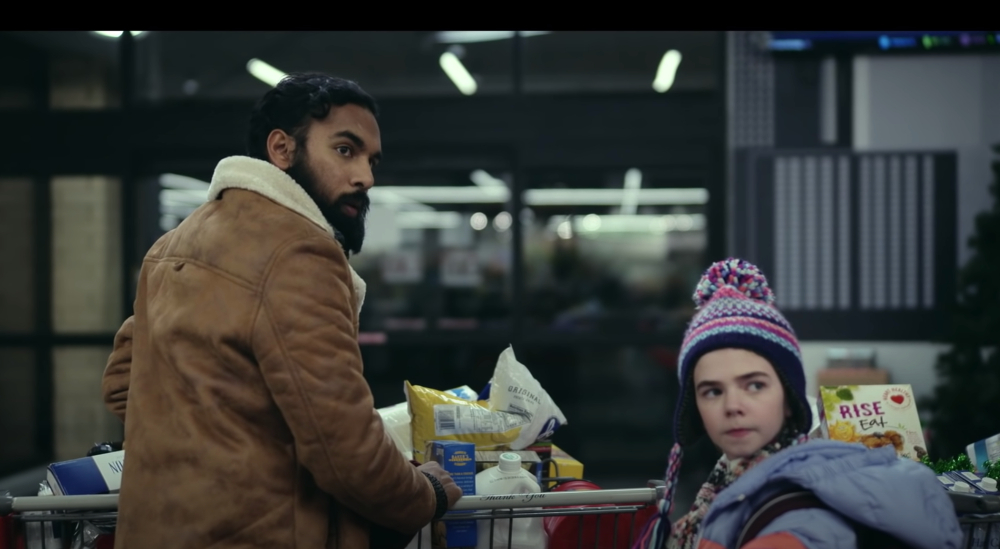
BTL: It’s an incredible scene. I should say the entire series is filled with these remarkable moments that don’t necessarily advance the narrative in predictable ways.
Cosens: Patrick’s great at writing scenes that are just kind of comments about who we are as people. Some of the scenes I find so poetic in the way that they deliver plot and character. It doesn’t feel heavy-handed, it lets you have some room to interpret what’s going on, to inject your own feelings or ideas. From the very beginning when I read the script, it was something that I was excited about.
BTL: How do you translate that into imagery? You are the one who has to capture that feeling.
Cosens: With Blaze, [director] Ethan [Hawke] and I shot that almost like jazz. We would go into a space and talk about which way we were going to shoot, where the light would come from. We would know ideally what we wanted to do, but we were always really flexible about which way the scene could go. If all of a sudden the actor wants to go outside, we just follow them, you know? Really improvisational in terms of the acting, but also in terms of how we blocked it and shot it. I love working that way and I know Ethan does too.
It’s a little easier to do that on an indie film with a smaller crew. You can be a little more agile and adaptive, you can all of a sudden just change things. When you’re shooting a TV series, that’s the constant fight. How do you get “life?” How do you get life in there? How do you allow for spontaneous moments? When you’re on such a tight schedule with a lot of actors and things like horses and wagons that you have to turn around to reset — I mean, DPs, we always talk about that. How do you let the life in?
I think it has to do with the collaboration between the director and the DP, because the director also has to be open to working that way, to allow that to happen. If the director is too controlling, then it just doesn’t happen.
I think more veteran directors, directors who maybe have more confidence in their experience, will allow things to be a little more fluid and a little more flexible. They know that process is part of it. That the life comes from letting the process evolve organically. I would say that the directors on Station Eleven were very much aware of that and comfortable with that approach. Were we able to do it all the time? No, but did we try to? Yeah, absolutely.
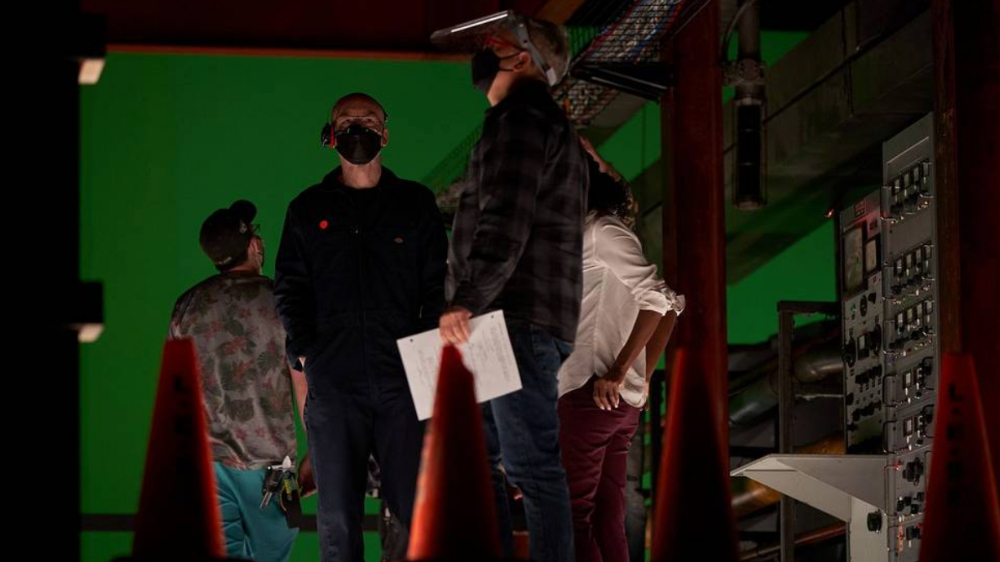
BTL: I know the COVID protocols affected how you worked, especially in terms of extras, but have they changed at all or become less restrictive since you shot this series?
Cosens: No, they’re pretty much all the same.
BTL: Do you think things will ever go back to the way they were?
Cosens: Jeez. I guess the bigger question is, ‘Will our society ever go back to normal? Will this ever end?’ I don’t know. Throughout all this, somehow, the film industry managed to keep going. It was amazing to me how supportive everybody was in terms of the protocols. We were all like, ‘okay, this is what it takes. Let’s do it.’
All episodes of Station Eleven are currently streaming on HBO Max.





